You SHOULD be utilizing email marketing on your website(s).
Not right out of the gate, but my general rule of thumb is: once the site gets 1k pageviews per month, start collecting email addresses.
Now, this isn’t an post on how to do that (but see how we generate thousands per month from one of our website’s email list). This IS a post on which email platform to use.
In the website building community, MailerLite, beehiiv, and ConvertKit are the three most popular options.
With a 10+ year background in advanced email marketing, an agency that performs email marketing as a service, and several websites of our own, we set out to answer the question:
beehiiv vs ConvertKit vs MailerLite- which should we use and when?
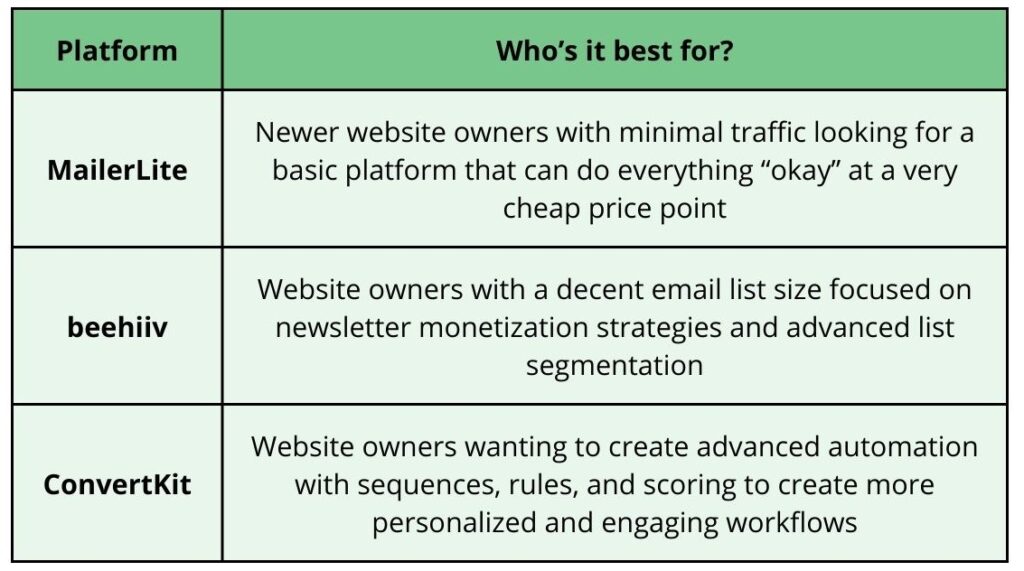
We answered the question for ourselves, and I thought I’d share our findings.
A few caveats: we attempted to be as accurate as possible with everything we shared below. Seriously, these are all awesome options, and we wanted to use data to guide our thoughts. If anything is incorrect, apologies (and let us know). There are affiliate links to the email platforms in this, but we don’t have any specific affiliations with any of them.
Quick Navigation
beehiiv vs ConvertKit vs MailerLite
To start, here’s a brief breakdown of the platforms:
- ConvertKit is known for its powerful automation capabilities and is geared towards creators.
- beehiiv is a newer platform with a simple, user-friendly interface and attractive pricing as you scale.
- MailerLite makes designing and sending emails a breeze with a drag-and-drop editor and customizable list management.
All 3 can do more than just send emails, ranging from creating webpages and blogs to selling digital products. To keep this hyperfocused (and less overwhelming!), I’m mostly focusing on features that you’d likely consider when you’re building an email list.
TLDR (and I get it… this is a long one) – If you don’t want to read everything, you can get a quick idea of our analysis by checking out the charts below, along with reading the verdict at the end.
First, take a look at the notable features of MailerLite vs beehiiv to see how they stack up:
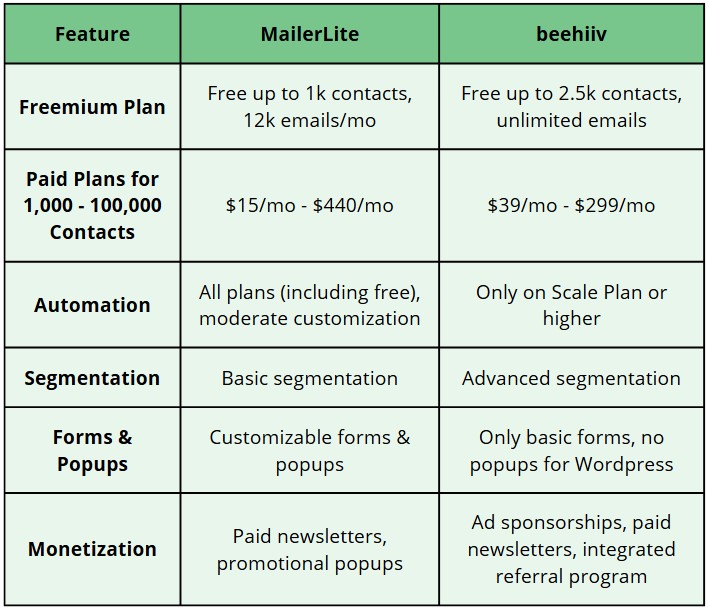
You can also see how beehiiv vs ConvertKit to compare:
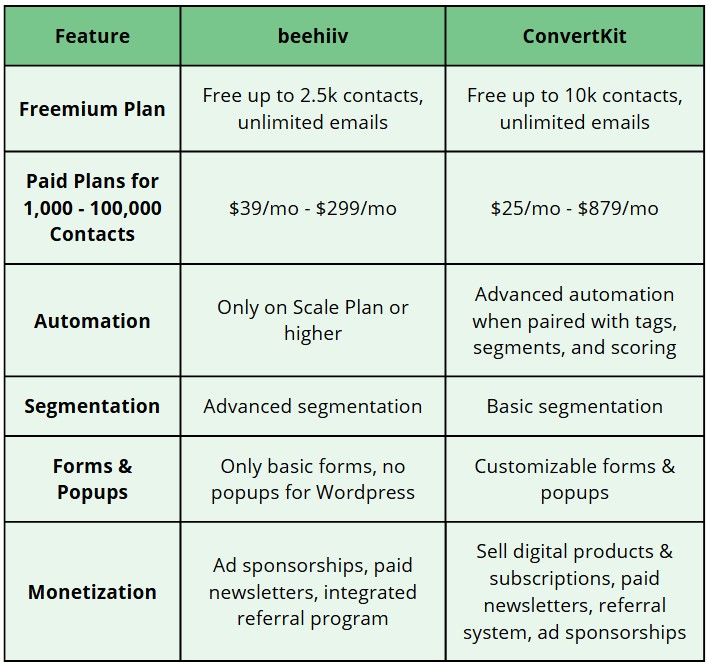
Why didn’t we compare MailerLite to ConvertKit in this review? Because, in essence, they are somewhat similar. ConvertKit is just far more robust, far more powerful, and far more expensive than MailerLite.
Why Listen to Us?
Apologies in advance for this section, but I think it’s necessary to set the stage for why we’re qualified to cover this topic.
When I initially wanted to write an email about email platforms, I turned to Kaitlin Cooper, my business partner and COO, for her expert insights on the topic.
She’s a pro at email marketing and has spent more time than she’d like to admit in deep diving platforms and building out engaging workflows. Together, we have run big marketing campaigns for my previous company, where we sent over 1 million emails per year through advanced automation sequences.
So, it’s not our first rodeo when it comes to email marketing.
We have extensively used advanced platforms, including Hubspot and Pardot / Salesforce, where we built intricate email marketing workflows that leveraged advanced segmentation and highly personalized lead and customer journeys.
Pardot’s team even commented that we had one of the most advanced workflows they had ever seen (and, it was not uncommon for Kaitlin to be teaching their support team how to do something, even when she initially reached out with a question).
Most niche site owners have not built and sent emails at this scale before, which is one of the reasons we feel both compelled and qualified to share our insights on the topic.
With that being said, please don’t JUST take our word for it. That would be foolish. Every site and brand is different. Your site might only have 1,000 subscribers, but they might be really and engaged and you could be pitching financial products that pay really well.
That’s different than someone who is focused on writing about wedding invitations, just started their site, and only want to send 1 pretty basic email per week.
Ok, now that that’s out of the way, let’s dive in.
Price
First, let’s start with the pricing. The reason we’re starting here is a lot of the features I talk about later are dependent on the plan you decide to select. So, having an idea of the price points going into this is important. (*Note: I’m sharing all the pricing based on signing up for an annual plan, not monthly plans)
MailerLite
If you’re looking for a platform that will cover your basic needs for sending emails, creating segments, and designing workflows for the best price possible, MailerLite is a good option.
MailerLite offers a free plan for up to 1,000 subscribers. Their free plan gives you access to a majority of the features that you’d need to get started in building a list.
A couple of things the free plan lacks are premade email templates, the ability to add in dynamic content into your emails for additional personalization, and unlimited monthly email sends (they cap you at 12,000 emails/month).
When you’re ready/ need to upgrade to a paid plan to unlock the additional features, their pricing is pretty attractive compared to beehiiv and ConvertKit.
Pricing starts as low as $9/mo for up to 500 subscribers (for clarity, you can stay on the free plan with up to 1k users, but if you want to unlock additional features, you have to pay).
Past that, the pricing gradually increases (the prices below are if you pay yearly):
- Up to 2,500 subscribers: $22.50/mo
- Up to 5,000 subscribers: $35.10/mo
- Up to 8,000 subscribers: $53.10/mo
- Up to 10,000 subscribers: $65.70/mo
- Up to 15,000 subscribers: $98.10/mo
Once you get to the 15k subscriber range, the pricepoint gets similar to what you’d be paying with beehiiv on their Scale Plan.
Until that point though, MailerLite is the most affordable option as you work on growing your list. It’s great for beginners who want a platform with decent features.
ConvertKit
ConvertKit used to only offer a free plan for up to 1,000 subscribers. However, this is where things get interesting. They now offer a free plan up to 10,000 subscribers. Yes, you read that right – 10k.
You get access to several standard paid features, such as unlimited opt-in forms/ pop ups, unlimited landing pages, unlimited email broadcasts, and the ability to tag and segment your audience.
So, what’s the catch? You can only have 1 basic visual automation and 1 email sequence on the free plan. If you’re planning to create highly targeted email funnels based on subscriber purchases or where they’re at in a lead journey, you’ll feel limited by this and will want to switch to a paid plan.
However, if you’re just trying to build a solid email list and want to serve consistent content to your users (that can still be personalized), this free plan is an excellent place to start.
One of ConvertKit’s strong suits is its ability to create robust and complex automations, and to unlock this feature (along with others), the pricing starts at $25/mo for up to 1,000 subscribers. As your list grows, so does the pricing, by quite a bit:
- Up to 3,000 subscribers: $41/mo
- Up to 5,000 subscribers: $66/mo
- Up to 8,000 subscribers: $83/mo
- Up to 10,000 subscribers: $100/mo
- Up to 15,000 subscribers: $125/mo
The price continues to increase from there, but you get the idea. You’ll end up paying the most on ConvertKit compared to the other platforms, especially once you exceed 10k subscribers. That’s why, if you can take advantage of their free plan, you definitely should!
Who might consider this platform, based on these prices (assuming their enticing free plan doesn’t work for you)? Someone focused on wanting to build intricate automation workflows to deliver a highly personalized experience to everyone on their email list.
beehiiv
beehiiv offers a free plan for up to 2,500 subscribers, which is better than MailerLite but lower than ConvertKit’s 10k subscriber allowance.
While you can send unlimited emails and create forms on the free plan, you’ll need to upgrade to fully utilize automation and most of their monetization tools.
To access those features, you’ll be paying $34/mo for 1,000 subscribers. That’s steep if you’re just starting.
Try beehiiv Free for 14 Days
All prices based on annual billing
Segmentation
What is segmentation? In short, it’s a way to categorize your contacts into groups so you can personalize the email content you send to them. You might categorize people by location, their engagement with past emails, or certain content they’ve clicked on on your website.
It might not sound important, but think about it like this: People have an attention span of eight seconds, which is less than a goldfish!
That means you only have 8 seconds to capture their attention with your email.
If you’re only creating emails to blast to your entire audience, you risk people disengaging or unsubscribing more easily. While there are other email strategies to keep people engaged, segmenting your list and sending more personalized emails to those lists is a good place to start.
For example, let’s say you have a website on Cooking. You might segment your list by people interested in the following:
- Grilling
- Baking
- Etc
Or, you could segment your list based on preferred cooking appliances to use:
- BBQ
- Frying on stove
- Air Fryer
- Baking
- Sous Vide
- Slow Cooker
- Etc
Or you could segment based on experience level. Beginner, Intermediate, Expert.
A different way to look at it is to segment your list on engagement. Highly engaged subscribers get certain emails (and usually more of them) while lower engaged subscribers get fewer emails.
You get the picture. This is the kind of stuff we currently do at our agency (and it’s pretty fun!).
When it comes to list and email segmentation for ConvertKit, beehiiv, and MailerLite, they all have the ability to create segmented lists and send those segments emails.
Each platform can create static, dynamic, and manual lists (though the exact terminology within each platform varies).
beehiiv
Overall, beehiiv’s segmentation is stronger than the other two, based on the numerous conditions and logic you can adjust for a given segment.
Whether you want to quickly and easily segment your audience by the channel they subscribed to your list from, a specific number of email opens, a custom field you created, or a combination of multiple factors and exclusions, you can get pretty detailed with the lists you build.
MailerLite
We’re combining these two platforms into one section, because overall, their segmentation capabilities are similar. They both include segmentation in all plans, including their free ones.
You can group contacts by filters such as location, specific custom fields, and signup date. It’s not as complex as beehiiv’s, but you’ll still have some decent options for segmenting your list.
ConvertKit
Looking specifically at segmentation, ConvertKit’s capabilities and filters are similar to MailerLite’s. On its own, the segmentation options are average. However, when used with “Liquid” (Convert Kit’s template language), you can add some pretty advanced dynamic content within your emails to further segment and personalize your emails.
For example, let’s say you’ve segmented your audience based on whether or not they’ve bought a course from you. Using Liquid, you can customize parts of the email to be unique for each of those segments without needing to write two separate emails.
Automation
Automation is a bit of an advanced email technique; however, it can have excellent results if executed properly. You may have also heard this referred to as an email responder series or email workflow.
Automations allow you to create strategic email sequences that subscribers can enter into based on specific triggers (such as filling out a form or popup, answering a question a certain way, or making a purchase).
It can be a great way to keep your audience engaged with content tailored to their interests.
MailerLite
Just like everything else about MailerLite, their automation workflows are middle of the road. You can create decent workflows with basic triggers and conditions throughout.
To be fair, MailerLite’s workflows have improved quite a bit over the years, so we could continue to see improvements in the future.
Unlike beehiiv where you can only send subscribers down one path per automation, MailerLite provides more customizability.
For example, you can have the workflows “branch out” based on certain conditions (such as how users engage with specific emails) or actions (such as adding/ removing them from a group).
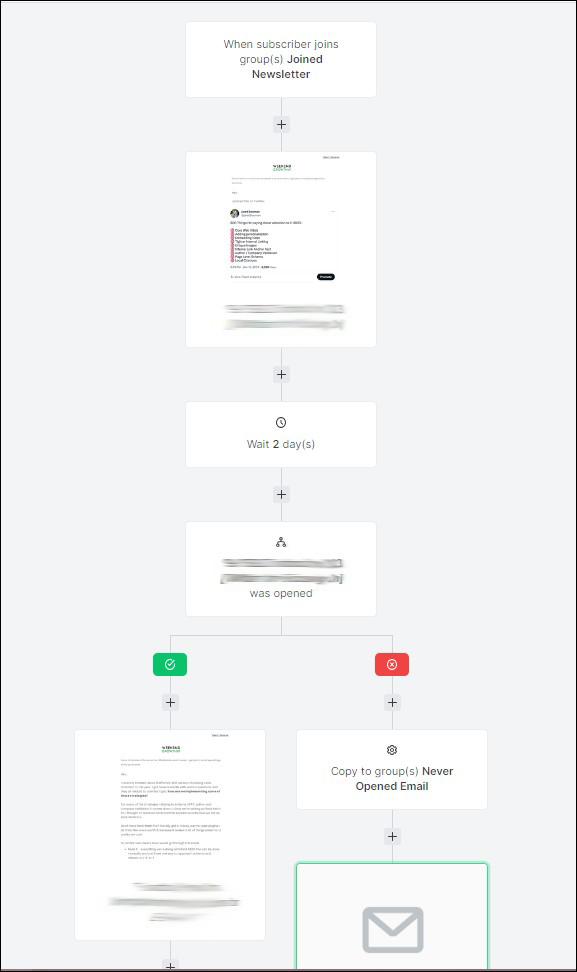
Another feature that MailerLite recently rolled out with their automations is the ability to A/B test emails within a workflow. This is an awesome feature that neither ConvertKit or beehiiv has, and it really allows you to test emails to see what your audience is most receptive to.
Overall, you can’t get quite as detailed or advanced as you can with ConvertKit, but if you’re newer to email marketing, you will likely find MailerLite’s automation features to do pretty much everything you need it to.
beehiiv
beehiiv falls short in this category. Not only do you have to pay for their most expensive plan to have access to Automated Journeys (that’s what they call “automation”), but it’s underwhelming in terms of how customizable it is.
There are only a few options to choose from for how someone enters into the workflow. Not only that, but within the workflow, the only action you can do is send emails (and set the delay time between each).
All users within the sequence go down the same path, regardless of how they interact with the emails or other data you’ve collected about them.
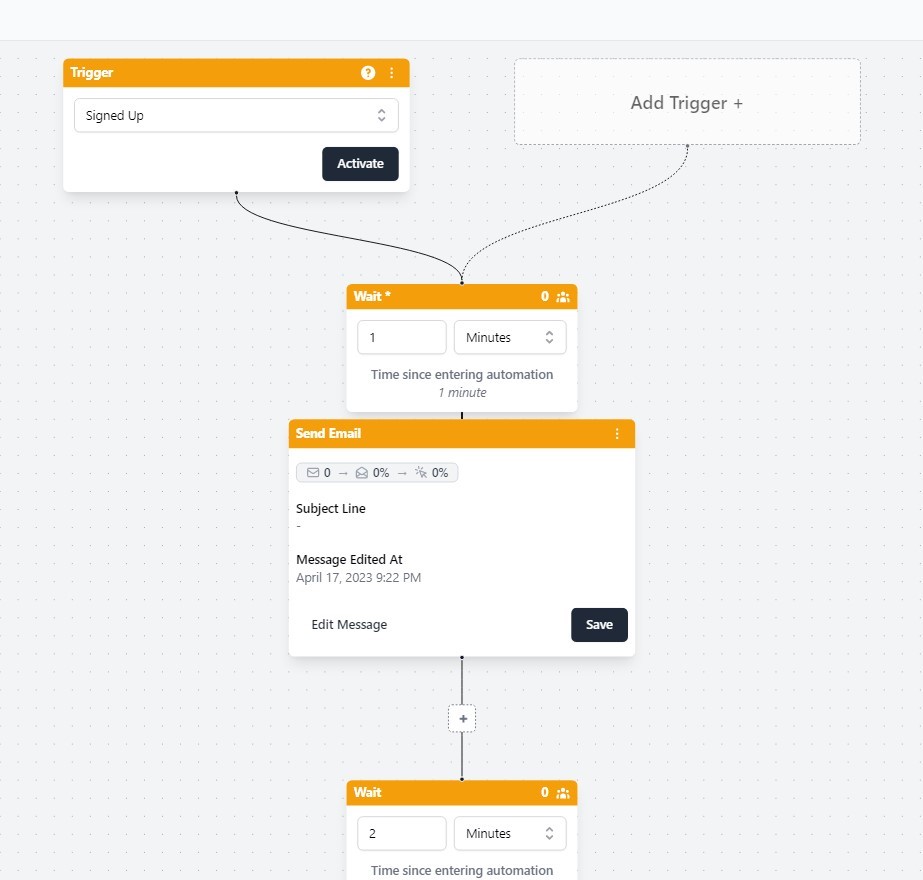
You’re not able to add in conditions or other triggers to allow the automation to branch out into other segments, providing a more personalized journey for someone.
That said, they are actively working on improving its workflows. So, while they still have a ways to go to be comparable to ConvertKit or MailerLite, it’s great to see them making updates.
ConvertKit
ConvertKit shines in terms of being able to design robust and powerful automation sequences.
While it’s not at the same level that we experienced when using marketing tools like Hubspot and Pardot, if you’re wanting to place an emphasis and focus on automation, ConvertKit is a good option.
This is especially true when combined with ConvertKit’s audience tagging, segmentation, and scoring, because it allows you to design very focused and intricate automation sequences for specific groups.
Based on how each user engages with your content while in the workflow allows them to have a completely different experience than another user. This gives you the opportunity to understand your audience on a deeper level, serve them content they’re genuinely interested in, and build their trust so they’re more likely to buy something from you.
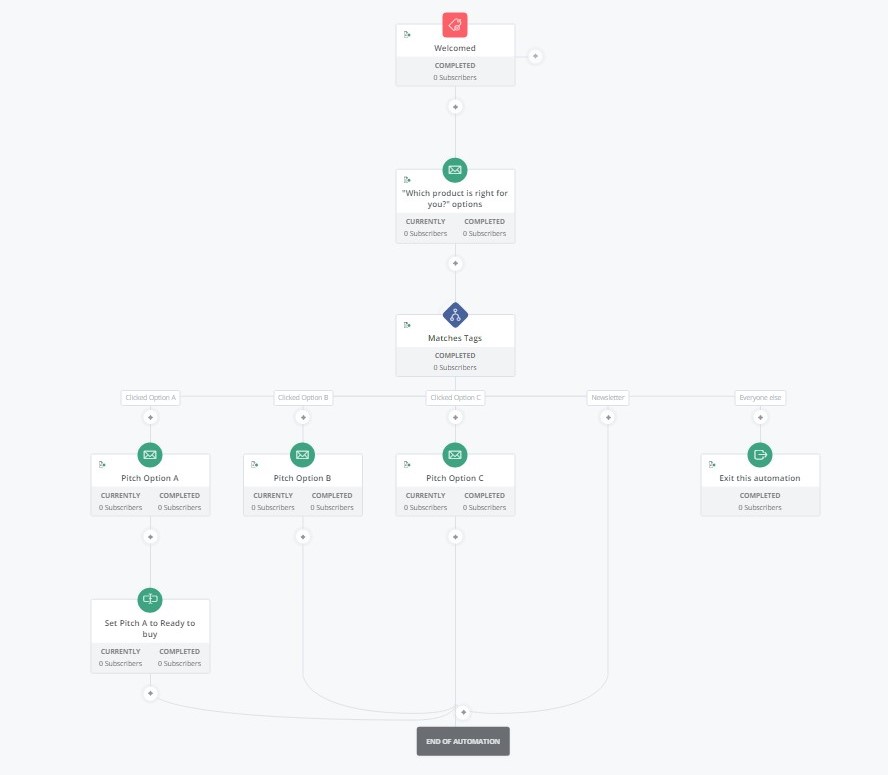
Deliverability
Deliverability is crucial when it comes to sending emails. You can write and design the best email, but if it’s not making it into people’s inboxes, your efforts will be wasted.
Before we dive into this topic, know that there are many factors that can impact deliverability. For example, are you:
- Sending from a custom domain or one such as a Gmail address?
- Taking the proper steps to authenticate your email domain?
- Using a shared IP address or a dedicated one? (there are pros and cons to both)
- Creating emails that readers engage with, or do you generally have low open and click rates?
- Using subject lines that could land you in the spam folder?
- Sending to a bunch of addresses that bounce?
- Landing in the inbox but then getting marked as spam, thus hurting future deliverability for all the emails you send
All of these items can impact your deliverability, to name a few.
So, what’s considered a good deliverability rate? There’s some variance, but Omnisend reports that anything over 95% is considered good, and EmailToolTester reports that anything above 89% is good (and over 95% is excellent).
We tried to track down data on all 3 platforms, but with beehiiv being relatively new, it was hard to find stats on their deliverability.
As for MailerLite and ConvertKit, here’s what EmailToolTester uncovered:

Based on this, both MailerLite and ConvertKit’s deliverability could use some improving (especially ConvertKit’s spam percentage).
Popups and Forms
Popups and forms are a crucial way to get email signups from your website.
beehiiv
Regarding popups, from what we saw, you cannot create a popup and then add it to your WordPress or Squarespace site. If someone has found a way to do this or we missed it, let us know! We were a bit surprised to see this was not an option.
A workaround to this would be to try connecting Zapier from your popup form to beehiiv so that new subscribers get added into beehiiv.
While you can’t create popups for your WP site, you are able to embed beehiiv forms. So in terms of giving people a way to sign up for your newsletter, there’s still a way.
However, on these forms, you can only ask users for their email address – there’s no option to add additional fields to the form, such as first name. This is unfortunate, since the ability to use someone’s first name in an email is pretty powerful.
In reading through some of their Knowledge Base articles, it sounds like the reason they only allow email addresses is “The advantage of this approach is higher conversion rates (as many readers do not want to include their personal information).”
Instead, if you want to ask for additional info, you need to create a survey that can be served to someone after they’ve initially filled out a form. However, this specific feature might only work on your beehiiv site and not your personal one through WP (we’re not entirely clear on this).
ConvertKit and MailerLite
Both ConvertKit and MailerLite work fairly similarly when it comes to how they handle forms and popups.
With both platforms, you can:
- Embed forms and popups on your website
- Use their WP plugins to quickly and easily embed
- Select a form to customize from a template gallery
- Add in additional fields to gather info such as first name, phone, etc
- Choose the timing of the popup (display after 5 seconds, exit intent, etc)
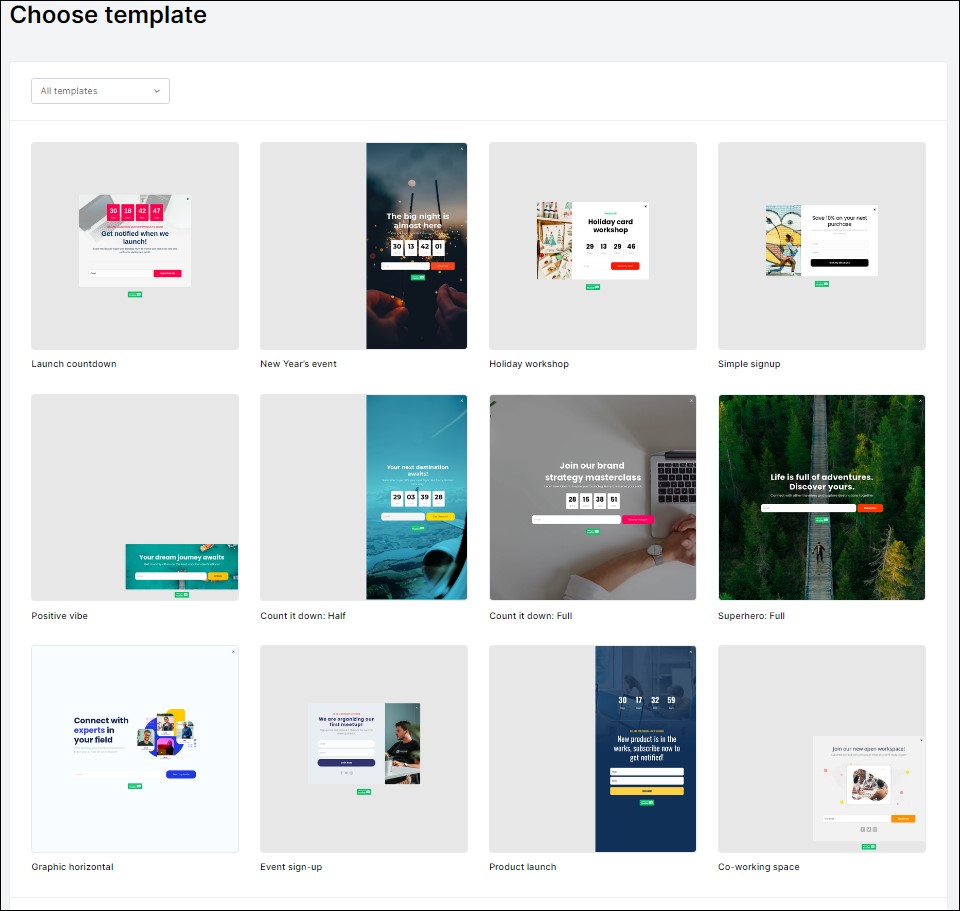
Overall, both platforms do well in this category and provide an effective way to gather email signups.
Monetization
If you’re just getting started with emails, monetization probably isn’t something you’re focused on quite yet. However, if you’re actively growing your list (or already have a decent list size), it’s worth knowing what each email platform provides.
MailerLite
MailerLite provides basic monetization methods, including the ability to sell digital products to your subscribers (ex: e-books) and offering paid newsletter subscriptions.
This is great if you want to test the waters with turning your email into a revenue generator to see if it’s something you’d want to do long-term. If it is, that could be an indicator that it’s time to move away from MailerLite and over to beehiiv or ConvertKit.
ConvertKit
Similar to MailerLite, you can sell digital products and run paid newsletters.
They also have a sponsor network you can apply for, where they’ll match you with premium advertisers and place sponsorships in your newsletters.
The downside is that you need to have at least 10,000 subscribers and email at least once per week to apply. On top of that, they charge 20% of total sponsorship revenue for selling and placing the sponsorship + 3.5% for payment processing.
beehiiv
beehiiv places an emphasis on helping you monetize your audience through premium subscriptions, an integrated referral program, and their ad network.
The bar is much lower to join their ad network compared to ConvertKit’s – you only need 1,000 subscribers and also need to be actively emailing them.
This, paired with the fact that beehiiv is cheaper ($84/mo compared to $100/mo on ConvertKit to meet the minimum ad network requirements) makes it almost a no brainer to go with beehiiv if monetization is your prime focus.
Cross Promotion
As you work to increase your list size, certain email platforms give you the opportunity to cross-promote newsletters within the community. This is a great way to grow your list and gain subscribers who are interested in your niche since you came recommended by another relevant newsletter owner.
MailerLite doesn’t currently have any opportunities for this, so we’re only focusing on ConvertKit and beehiiv.
ConvertKit
ConvertKit’s Creator Network is a powerful tool that allows you to grow your email list (and help other Creators grow their lists as well). Essentially, after someone subscribes to your email list, you can recommend other Creators that you think your audience might also like.
By being a part of the Creator Network, other Creators can recommend subscribers to your newsletter, which increases your reach and your total list size. You can also see which Creators are recommending you and how many subscribers you’re getting from them.
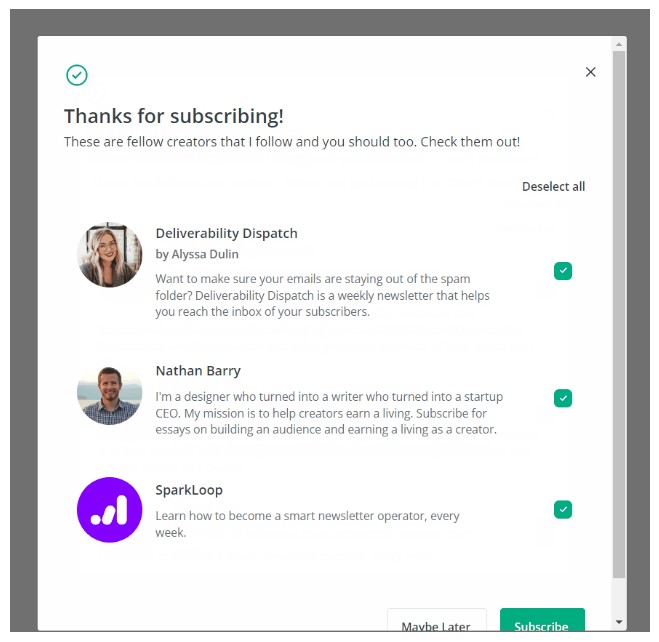
beehiiv
beehiiv also gives you the ability to cross promote newsletters within their network. It works similarly to ConvertKit’s Creator Network and it’s easy to find relevant publications to recommend to your audience. When you choose to recommend a specific newsletter, they’ll be notified and have the option to recommend you back.
UI Design
When you login to beehiiv, it feels modern and up-to-date. It’s really easy to navigate through, and they keep the pages simple and clean.
The sidebar is organized nicely with dropdowns. After spending just a few minutes within the platform, I was able to find my way around without much trouble.
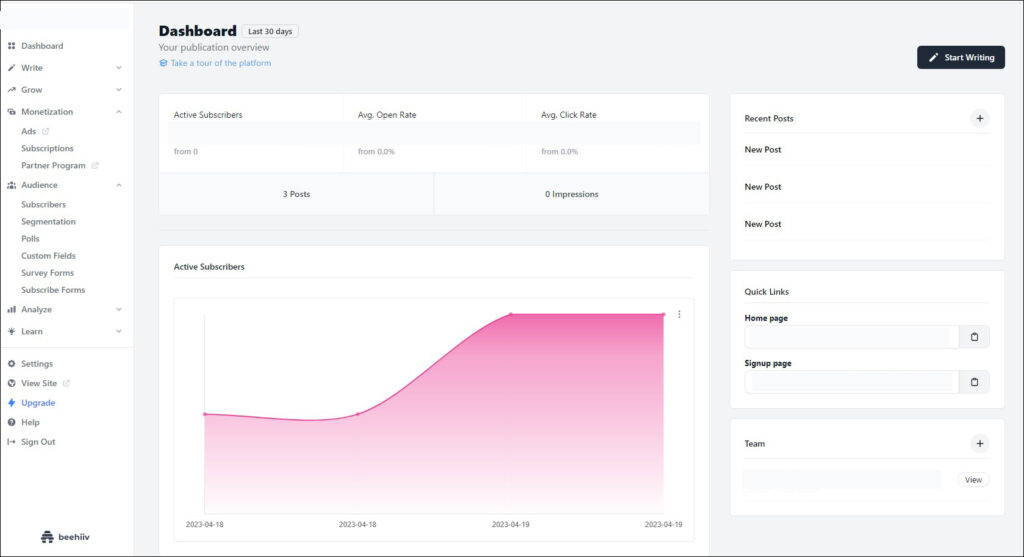
With MailerLite, it’s not quite as intuitive, and it feels slightly dated and clunky at times. The sidebar lists out the main sections, but in order to see everything within them, you need to click through.
But, for the lower price point, I don’t find it to be too bothersome.
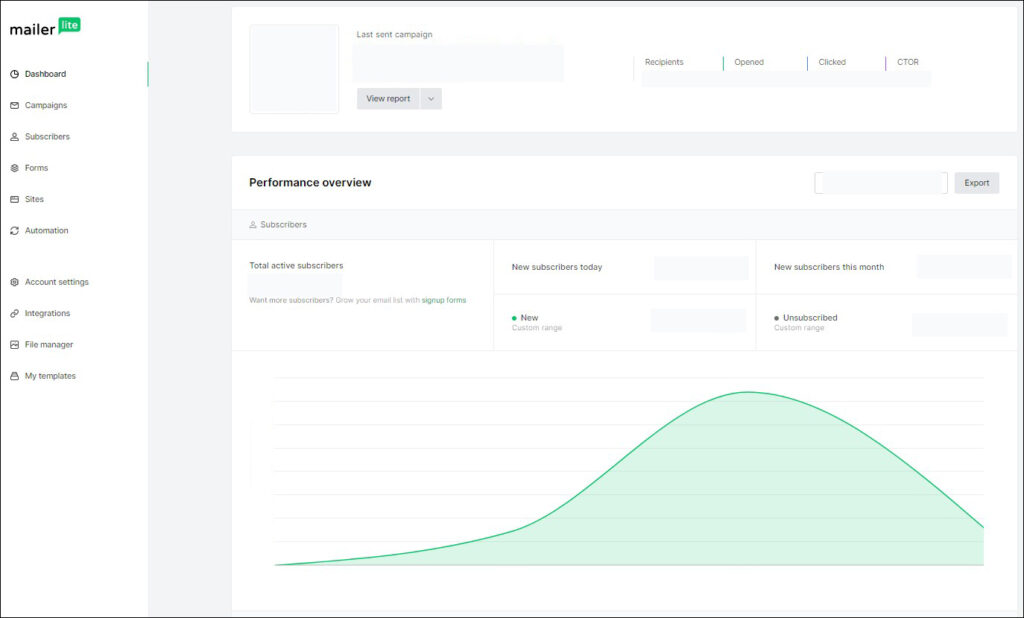
ConvertKit’s design looks and feels a bit more sophisticated and techy (which is nice to see, based on paying more). They map out their automations in a way that makes it easy to visually see the journey you’ve created for users.
However, their email builder is the hardest to use out of the 3 platforms. While you can fully customize your emails, if you start with one of their templates, some of them are not very simple to adjust.]
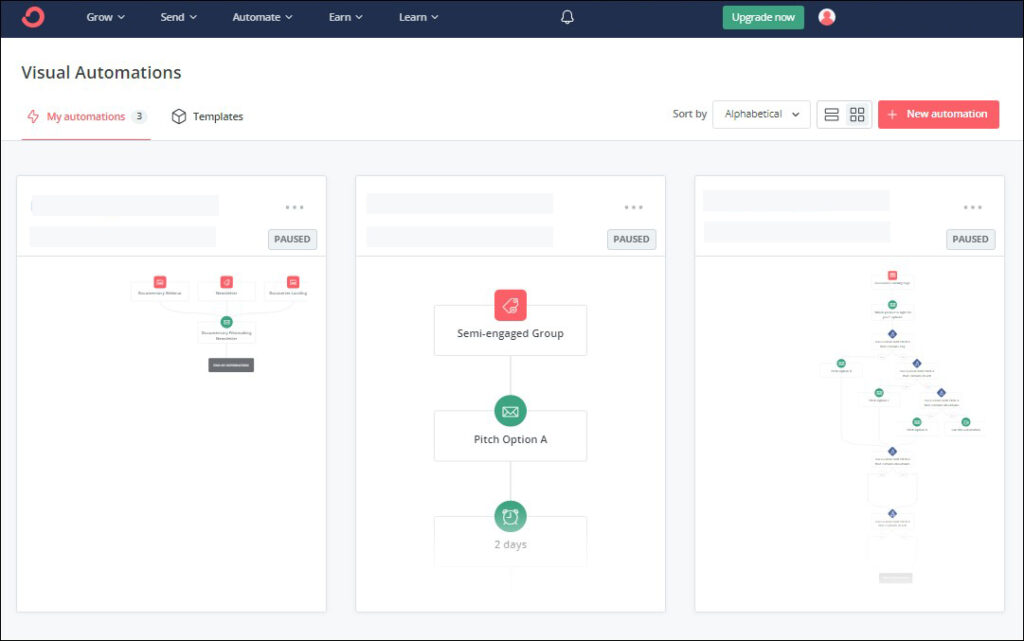
Integrations
When it comes to integrations, ConvertKit offers the most options.
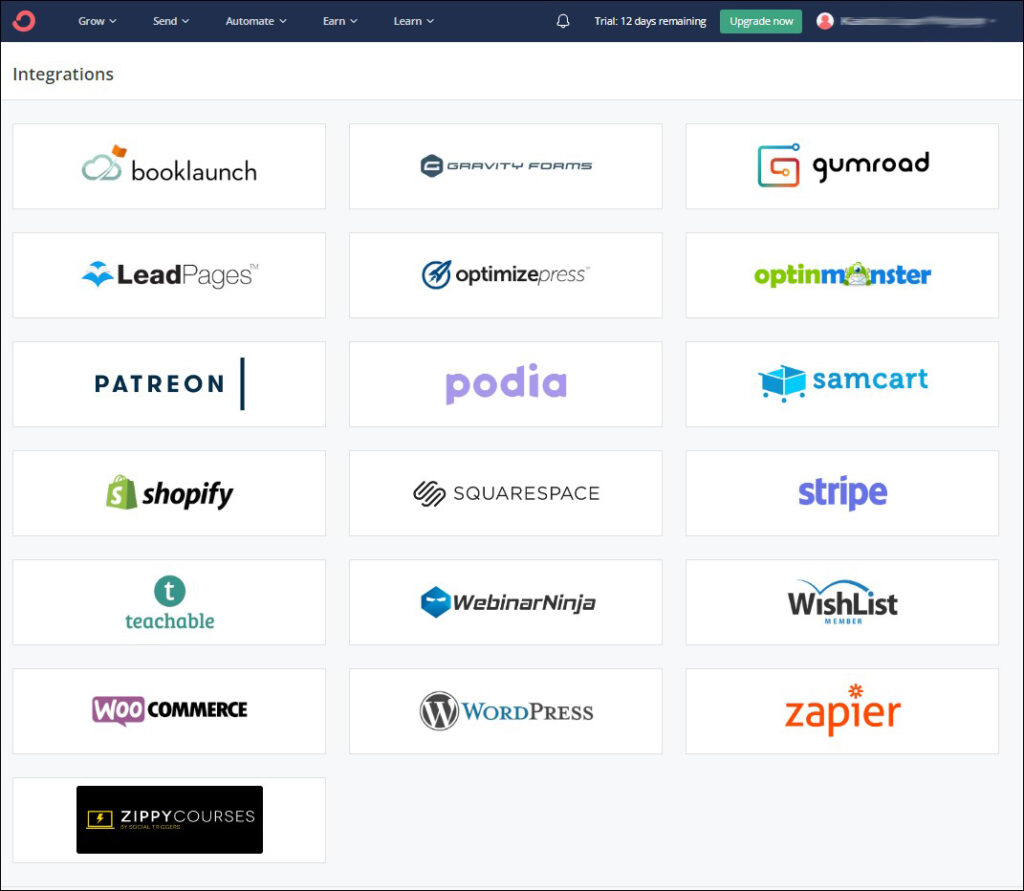
This is followed by MailerLite, then beehiiv. They all integrate with WordPress, Shopify, and Squarespace.
Additionally, all of the platforms integrate with Zapier though, giving you more flexibility past what you see on each of their Integration pages.
Verdict
So, which email platform should you go with? Here’s our thoughts:
If you’re interested in getting bang for your buck and having access to a lot of decent features, MailerLite is a very good option. MailerLite is the “jack of all trades, master of none” when it comes to email platforms – it does well at a lot of things, but doesn’t excel at one in particular.
🎯 We use MailerLite on all of our websites that have minimal traffic, and we stay with MailerLite until 5,000 – 10,000 email subscribers.
If you’re less concerned about the pricing and want to create some awesome workflows that take your users on a highly personalized journey, we would opt for ConvertKit. We would want to have a highly engaged subscriber list first, and be selling some nice products, which would offset ConvertKit’s high cost. As a bonus, they give you access to some good monetization features with low transaction fees.
🎯 For websites with highly engaged subscribers, or websites that feature high ticket products, ConvertKit is where we land.
If you have a decent sized mailing list that you regularly email and are ready to go all-in on monetization strategies, then beehiiv is great. They’ve created a platform that is intuitive, easy to use, and does segmentation really well. While their automation workflows could use some improvements, their segmentation combined with personalization is powerful. Niche website owners will love the ability to further monetize and take advantage of the Creator Network as well.
🎯 Once you outgrow MailerLite, if you don’t want to spend all the time and money on creating advanced workflows, beehiiv is a very good all-in-one solution (provided you can navigate around a few of the hassles).
We can set up your email newsletter for you, including adding a pop up and lead gen e-book! Learn more here!
Final Thoughts
Based on your prerequisites and priorities, here you go!
- Price: MailerLite (cheapest) → beehiiv → ConvertKit (expensive)
- Segmentation: MailerLite (least options) → ConvertKit (more options if used with Liquid) → beehiiv (best)
- Automation: beehiiv (basic) → MailerLite (middle of the road) → ConvertKit (robust)
- Popups/Forms: beehiiv (limited) → MailerLite / ConvertKit (robust)
- Monetization: MailerLite (least options) → ConvertKit (more options but pricey) → beehiiv (best)
- Cross Promotion: ConvertKit / beehiiv (best) → MailerLite (no option)

